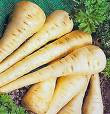Growing Parsnips
Parsnips are more versatile than many people are aware for they can be used in several different ways; boiled, roasted, and fried they are a delicious change from potatoes in many of the recipes where we would normally use spuds. They are really delicious made into chips or crisps with a lovely mild, slightly sweet flavour, mashed with a little butter, served on they're own, or mixed with potatoes or some other root vegetable such as carrots, they are superb.
Soil Preparation
Parsnips will grow equally well in heavy clay or light loam but the soil does need to be deep and well manured from a previous crop, or manured in autumn of the previous season, otherwise the roots will fork instead of growing straight and clean.
Sowing
The parsnip is usually the first vegetable crop to be sown each year, in the south they can be sown at the end of February, whilst it is normally the end of March in the north. If they are sown later in April, then they tend not to grow as large but they are more likely to germinate better because the ground will have warmed up.
Drills should be 1in. (25mm) deep and about 15 in. (381mm) between rows. Because parsnip seed germinates badly, it is less important that seed is sown thinly. The fact that they germinate slowly does have its advantages because other quick growing crops such as radish may be sown with parsnips for when space is required for the host crop, the catch-crop (the radish) will be ready to harvest.
General Care
Keep the ground free from weeds but take great care not to damage the root, as they will succumb to canker. Make sure that they have plenty of water to prevent the roots from splitting and so that they are able to develop and grow well.
Harvesting
Parsnips are slow growing occupying the ground for several months before they are ready to lift; they may be dug up any time after the foliage begins to die away. They taste better when they have been touched by frost as this will sweeten them adding to their flavour, and therefore they may be left in the ground until late in the winter. If the ground is needed for other crops before the frosts have arrived, the parsnips may be dug up and left on the ground in a heap, where they can await the frosts. In excessively hard frosts the roots should be taken into a dry shed and covered with a sack, alternatively they can be stored in boxes of peat or Vermiculite.
Terry Blackburn. Internet Marketing Consultant, living in South Shields in the North-East of England. Author and Producer of blog http://www.lawnsurgeon.blogspot.com Author of "Your Perfect Lawn," a 90 Page eBook devoted to Lawn Preparation, Lawn Care and Maintenance. Find it at [http://www.lawnsurgeon.com]
I would be very interested to have your comments on this Article.
Article Source: http://EzineArticles.com/?expert=Terry_Blackburn
Growing Parsnips
Hi my Name is Darren
I Started Growing my Own Food a few Years ago and i Love it.
When I Started it took Age's to find the Best information on How To Grow my Own Food.
So I have Put Together Some of The Best info I Found to Help others Like me to Grow there own.
Hope you Like it and i Hope it Help's
more will be added as i Find The Best info
Thank's Darren
When I Started it took Age's to find the Best information on How To Grow my Own Food.
So I have Put Together Some of The Best info I Found to Help others Like me to Grow there own.
Hope you Like it and i Hope it Help's
more will be added as i Find The Best info
Thank's Darren
